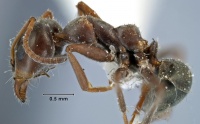Iridomyrmex tenebrans
| Iridomyrmex tenebrans | |
|---|---|

| |
| Scientific classification | |
| Kingdom: | Animalia |
| Phylum: | Arthropoda |
| Class: | Insecta |
| Order: | Hymenoptera |
| Family: | Formicidae |
| Subfamily: | Dolichoderinae |
| Tribe: | Leptomyrmecini |
| Genus: | Iridomyrmex |
| Species: | I. tenebrans |
| Binomial name | |
| Iridomyrmex tenebrans Heterick & Shattuck, 2011 | |
As is the case with several other members of the I. viridigaster complex, this species seems to be exceedingly rare, and is known only from the holotype, collected at Crowdy Bay, New South Wales. Nothing further is known of this ant.
Identification
This species is distinguished by its dark appearance from other members of the complex with a hairy mesosoma and erect setae on the hind tibiae.
Keys including this Species
Distribution
Latitudinal Distribution Pattern
Latitudinal Range: -31.78333282° to -32.472695°.
| North Temperate |
North Subtropical |
Tropical | South Subtropical |
South Temperate |
- Source: AntMaps
Distribution based on Regional Taxon Lists
Australasian Region: Australia (type locality).
Distribution based on AntMaps
Distribution based on AntWeb specimens
Check data from AntWeb
Countries Occupied
| Number of countries occupied by this species based on AntWiki Regional Taxon Lists. In general, fewer countries occupied indicates a narrower range, while more countries indicates a more widespread species. |

|
Estimated Abundance
| Relative abundance based on number of AntMaps records per species (this species within the purple bar). Fewer records (to the left) indicates a less abundant/encountered species while more records (to the right) indicates more abundant/encountered species. |

|
Biology
Castes
Nomenclature
The following information is derived from Barry Bolton's Online Catalogue of the Ants of the World.
- tenebrans. Iridomyrmex tenebrans Heterick & Shattuck, 2011: 147, fig. 78 (w.) AUSTRALIA.
Type Material
- Holotype, worker, Crowdy Bay National Park, 10km S Laurieton, New South Wales, Australia, 31°47′0″S 152°45′0″E / 31.783333°S 152.75°E, September 1992, E. A. Davidson, ANIC32-013752, Australian National Insect Collection.
Description
Worker Description. Head. Posterior margin of head planar to weakly concave; erect setae on posterior margin in full-face view set in a row; sides of head noticeably convex; erect genal setae absent from sides of head in full-face view (one to a few small setae may be present near mandibular insertion). Ocelli absent; in full-face view, eyes set at about midpoint of head capsule; in profile, eye set anteriad of head capsule; eye semi-circular. Frontal carinae straight; antennal scape barely attaining posterior margin of head, or surpassing it by less than 1 x its diameter. Erect setae on scape absent, except at tip; prominence on anteromedial clypeal margin present as an indistinct swelling or undulation; mandible regularly triangular with oblique basal margin; long, curved setae on venter of head capsule present. Mesosoma. Pronotum moderately and evenly curved over its length. Erect pronotal setae numerous (12 or more), short and bristly. Mesonotum evenly curved. Erect mesonotal setae moderate in number (6- 12), short and bristly. Mesothoracic spiracles always inconspicuous; propodeal dorsum protuberant; placement of propodeal spiracle mesad, more than its diameter away from propodeal declivity; propodeal angle present as a bluntly defined right angle, the dorsal and declivitous propodeal faces never separated by a carina. Erect propodeal setae numerous (12 or more), short and bristly. Petiole. Dorsum of node convex; node thin, scale-like, orientated anteriad. Gaster. Non-marginal erect setae of gaster present on first gastral tergite; marginal erect setae of gaster present on first tergite. General characters. Allometric differences between workers of same nest absent. Colour reddish-brown. Colour of erect setae whitish.
Measurements. Worker (n = 1)—CI 95; EI 26; EL 0.28; EW 0.23; HFL 1.23; HL 1.11; HW 1.06; ML 1.42; MTL 0.84; PpH 0.25; PpL 0.60; SI 85; SL 0.90.
Etymology
Latin: ‘rendered obscure’.

